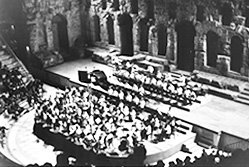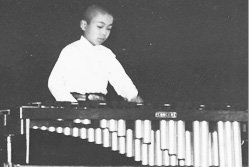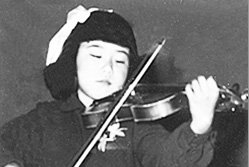YuYu interview Tatsuo and Shigeko Sasaki

| —— Can you tell us what you’ve been doing lately? 
At the Athens Festival in Greece, August 5, 1969.
Tatsuo We both have been with the San Diego Symphony since 1973. She is a violinist and I am the principal timpanist. From October through May every year, we perform in orchestral and opera concerts; from July through August, we perform at the “Summer Pops” outdoor concerts. Shigeko In addition to playing symphonies and operas, we perform with the San Diego Chamber Orchestra, make recordings, and play chamber music. Although we are extremely busy, we’ve never skipped practice; practice is important for us to maintain our skills and technique. —— How did you discover music? 
Tatsuo playing the marimba at a“Piano Opening”ceremony in elementary school, 1957.
Tatsuo It all started by chance. When I was in first grade, I was assigned to play the xylophone for a talent show at school. My classroom teacher, a music teacher, realized I had a talent for music when she heard me play. When my father learned of this, he was very enthusiastic. He went out to buy lumber and made a xylophone for me. In those days, there were only two xylophone players in Japan, Yoichi Hiraoka and Eiichi Asabuki, and they were popular throughout the country. We enjoyed listening to their performances on the radio every morning. Mr. Hiraoka later became my xylophone mentor. I’d listen to their music every morning while I practiced on my own. Shigeko My mother was very open-minded for a Japanese woman born and raised in the Meiji Era. She learned English and piano from British missionaries on a special program at a mission school. Later, she became a Christian and an organist for her church. My mother loved playing the piano and wanted me to learn it as well. But, it was right after the war. We couldn’t afford to buy a piano. Instead, Mother bought me an organ. That determined the course of my life. —— How and why did you go to music college? 
Shigeko studying violin at her mother’s encouragement, 1953.
Tatsuo When I was in fifth grade, I was invited to play the xylophone at a “Piano Opening” ceremony. In those days, many schools would hold such a ceremony after purchasing a piano and my performance was well received. Playing the marimba in public had become a routine for me and I thought about becoming a professional xylophone player in the future. When I was a high school senior, I prepared for the entrance examination for the Tokyo University of Fine Arts and Music. I made a trip from my hometown of Okayama to Tokyo every month and took lessons from an instructor teaching at the university. So I learned percussion instruments, singing, piano, solfeggio, etc. It was before there was a Shinkansen (bullet-train), so it took me fourteen hours to reach Tokyo by overnight train. Shigeko I was born a month before the end of the war. I was the youngest of six siblings in my family. The food situation in Japan was terrible at that time. My father, a graduate of Kyushu University, Faculty of Agriculture, had started dairy husbandry. He was determined to save children in Japan who were suffering from hunger. So he had quit his office job and went to the countryside, and started cultivating land there. He was rather academic, so he considered music as entertainment. At first, he didn’t accept my mother’s wish to let me to study piano. Yet, her enthusiasm finally persuaded him to allow me to study piano. First, I went to a senior high school in Osaka, aiming to pursue a music career, but later, I transferred to a girls’ school in Tokyo at my mother’s request. In those days, it was common for students wishing to enter music colleges in Tokyo to travel to the city for music lessons. After graduating high school, I went to the Kunitachi Conservatoire. It was my mother’s strong will that made me a musician. I’d say. —— How and why did you join the San Diego Symphony? Tatsuo While studying at the Tokyo University of Fine Arts and Music, I learned about the Fulbright Program (US government-sponsored scholarships for foreign students). I’d been a fan of the US since I was small, so I applied for a Fulbright scholarship and got it. On the scholarship, I studied at the Juilliard School of Music in New York for two and half years. Afterwards, I performed with the American Symphony and the Israel Philharmonic Orchestra for two years, accepting an invitation from its conductor Zubin Mehta. In 1969, I returned to Japan and joined the Japan Philharmonic Orchestra conducted by Seiji Ozawa. After I performed with the Japan Philharmonic for three years, Shigeko and I joined the Brazil Symphony and later the San Diego Symphony. Shigeko After graduating from the Kunitachi Conservatoire, I performed in a Yomiuri new talent showcase concert in Tokyo. Afterwards, I joined the Japan Philharmonic Orchestra for which Mr. Seiji Ozawa was the principal conductor. Then I got married and moved to Brazil. We’ve always made important decisions at the last minute…our marriage, moving to Brazil, and coming to San Diego, etc. In September 1973, we moved from Brazil to San Diego, with our new-born son. —— How did you meet each other? 
At the Recital Hall of the Tokyo Bunka Kaikan, 1970.
Tatsuo I met Shigeko when I joined the Japan Philharmonic Orchestra, where she had been performing as a violinist. Well, while performing in Japan, I came to feel that the Japanese seniority system was preventing me from becoming a principal timpanist. I missed the free spirit of the American and Israeli orchestras. One day, I learned that the Brazil Symphony based in Rio de Janeiro was looking for a timpanist, so I applied for the position right away. The conductor examined my curriculum vitae and hired me on the spot without auditioning. He was also looking for a violinist, so I contacted Shigeko right away. As I look back, that was my way of proposing to her. (Laughter) Shigeko When he came back from Israel, he looked like an eighteen-year-old, weighting 10 kilograms less than he does now. When I listened to his percussion, though, I became interested in him. He had an exceptional sense of sound and rhythm. I realized that and started thinking of him. Still, we were just friends; we just talked to each other at rehearsals or having lunch with other friends. One morning, I received a phone call from him. “Can you come now with your violin?” he asked. So I went to the hotel where he and the conductor of the Brazil Symphony were waiting. I’d felt close to Brazil because my brother and uncle had emigrated to the country. I auditioned and passed it on the spot. Tatsuo and I looked at each other and said, “What are we going to do?” (Laughter) Ten days after the audition, we got married. A month later, we left for Brazil. —— What have been some of your outstanding achievements? 
At a performance of the San Diego Symphony, 1995.
Tatsuo One is that I passed the Fulbright Scholarship examination and achieved the top score. That gave me unshakable confidence. Out of 100 examinees, I was the only one who was provided with the full cost of studying and living abroad. I was also the first percussionist who had passed the exam. Another has been performing with the world-class orchestras, conductors, and soloists while playing with the Israel Philharmonic Orchestra. That allowed me to touch, understand, and interpret the quintessence of music, which has been the ultimate treasure for me. Finally, I’ve enjoyed success in releasing a xylophone CD through Musical Heritage, Inc. that has sold over 10,000 copies. Shigeko I’d say one of my achievements is that I graduated from my university as its top student. Another thing is that I’ve been performing with three international orchestras for a total of 37 years. Our son was born in Brazil and our daughter in San Diego. Both are now medical doctors. I’ve accomplished my role as a mother and I feel relieved. I am proud that I’ve managed both family life and work in a foreign land. I call it my ultimate achievement. —— What do you do to hone your skills? Tatsuo The timpani makes the base sound for an orchestral performance. It also tightens up the entire performance. Playing the timpani requires constant attention to timing, tones, nuances, and volume. So I thoroughly study both the full score and the individual parts to try and understand the entire structure of the piece as well as the individual harmonies. Shigeko Playing the violin requires an unnatural posture, which isn’t good for the body. While continuing to play for many hours every day, I’ve been having problems with my shoulders, neck and back. So I started doing Qigong (a Chinese exercise system) after a friend of mine recommended it. Since learning how to relax my body, I’ve felt better. Managing one’s own health is the first priority, I’d say. —— What have been your happiest and most painful moments? 
At a performance of the San Diego Symphony, 1975.
Tatsuo I feel happiest when I am totally focused on performing, integrating myself into wonderful music. By repeating such experiences, I’ve been able to improve the quality of my music. The most painful moment … that’s when I’ve reached my limit. I believe talent is innate and I am grateful for the talent I was given. Yet, when I want more, I feel difficulties. When it comes to pursuing the arts, no one can be completely satisfied. Even a first-class musician pursues the ultimate goal until the end of his or her career. That’s why the arts are eternally attractive. Shigeko My idea of bliss is being in nature. I feel happiest when I am blending in with the trees, flowers, and plants. Painful moment? As a musician, it’s important for me to maintain myself in the best mental and physical condition for upcoming performances. So I must always be vigilant. This requires exceptional patience. Paradoxically, I have been consoled by the power of music whenever I encounter difficulties in my daily life. In the evening, we dress in black and jump into a different world. When we are done with work, we return to the real world. I think living such a two-dimensional life has rescued us from the earthy reality of life. —— Can you tell us about the benefits of music? Tatsuo Music is a way of expressing spiritual states of human beings at a higher level, including emotions. It offers the listener pleasure, grief, anger, relaxation, healing, etc. Some say that listening to selected pieces of classical music relaxes the left brain, the logical brain, while it also vitalizes the right brain, the image brain. The purpose of music is to convey human spiritual states, which is hard to express in words, to other people via sound. Music is also interpreted and expressed in various ways through subjective factors, such as the performer’s personality, life experience, and views. This is another attraction of music. It’s not too much to say, that for a musician, music is his or her life. Shigeko If children have been exposed to classical music since early childhood, they’ll develop a strong power of expression and a good sense of sound, which will allow them to hone their sensitivity. Accordingly, they’ll improve their imagination, expanding their unique worlds. Also, if children have managed to learn to play an instrument on their own, they’ll become generally patient. In the same way as learning a language, the earlier a child is exposed to music, the faster he or she acquires musical skills. For example, children learn with ease the difficult and complicated skills required in playing the violin, which are physically and mentally demanding. Even if they stop taking lessons four or five years after they started their lessons, they will never lose their sensitivity that they have acquired through music. —— Can you tell us about the Sasaki School of Music? 
At the wedding ceremony for daughter Maki, March 2005. From left to right: Shigeko, Tatsuo, Maki, Toshiyuki Minami (bride), Jun (son of Mr. & Mrs. Sasaki), Mui (Jun’s wife), Benjamin (son of Jun and Mui), March 2005.
Tatsuo We opened the school in the hope of passing on to younger generations the art of music and musical skills that we’ve learned for half a century. We teach violin and percussion instruments in general, including marimba, snare drums, and timpani. You can jump in and start if you have two sticks. You don’t have to aim to be a musician. One of our goals is to help students acquire a sense of rhythm and a way of enjoying life through music. We offer a weekly private lesson. We also hold recitals. We started the school on our own. In the future, we’ll seek help from those who have the same mission as we do to see the school grow as a comprehensive school of music, where all kinds of instruments are taught. Shigeko Until recently, I’d thought I would do something other than music when I retired. I was interested in living a totally different life because I’d devoted my life to the violin. But, I realized that playing the violin had become a part of me. When I began considering retiring in the near future, I suddenly started having this sense of mission, “We must pass on to the younger generations what we’ve learned!” I strongly believe it is necessary to do so especially because today’s young people are less interested in classical music. A basic knowledge of classical music is useful for children even if they become interested in jazz or rock music later in their lives. I’d like to see success in our students with whom we have shared the joy of music. It would be my ultimate pleasure to see some of them become professional musicians, regardless the field. (10-01-2005 issue) |

